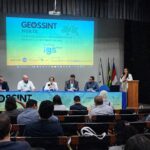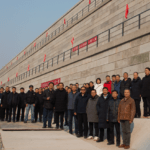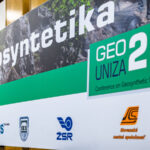With more than 100 members and its 10th anniversary next year, the Iran Chapter of the IGS is optimistic about the months ahead. Here, its President Seyed Naser Moghaddas Tafreshi shares the fascinating challenges and opportunities for geosynthetics in Iran, and developments in the chapter.
When was the Iran chapter formed?
The Iran chapter was established in 2012.
Tell us a bit about your membership.
We have 104 individual members including students and non-students. The non-student members consist of professors from universities and research centers as well as experts from the Geosynthetics Industries (GI).
Currently, we have no corporate members. We used to have them but as the Iranian currency has been significantly devalued within the past few years, the manufacturers opted for individual membership. We will be attempting to encourage them to enroll as corporate members again.

What are your chapter’s key activities?
The chapter is heavily engaged in organizing technical webinars – previously in the form of seminars! Moreover, we have formed technical committees including Soil Reinforcement and Hydraulic and Barrier Systems in which quite a few highly motivated young researchers are active.
Our focus is on different aspects of the GI requirements, notably preparing/updating standards and design methods, optimizing products, and sharing new ideas in the context of novel manufacturing processes. We pay special attention to promote quality control and quality assurance of the products.
Do you have a youth section? What initiatives/events do you have for younger members?
One of the main advantages of the scientific committees is the possibility of attracting the attention of young researchers towards IGS activities. We used to have programs like the GeoWall competition, where students have to design and build a model retaining wall using paper reinforcement attached to a poster board wall facing to hold back sand. Students learn about geo-wall structure and the calculations and methods involved in real construction cases. However, due to Covid-19 and some other issues, the competition has not been possible in the last two years.
We do, however, get the young members involved in webinar-related tasks such as technical communications with participants, giving a lecture in the Persian part of the webinar, and organizing the participation of sponsors.
What are you proud of in the chapter?
We are proud of successfully getting more manufacturers and contractors involved in our activities. Also, expanding the applications of geomembranes and GCLs in urban deep excavations, ponds, artificial lakes, and so on.
Tell us a bit about the geosynthetics market in Iran. What is the level of understanding and adoption of geosynthetics?
Iran’s geosynthetics community is like a pyramid in which manufacturers, designers and contractors are at the base and the quality controllers are on the top. In Iran, this structure is still quite young and therefore, it is important to arrange seminars and webinars to educate and promote the greater use of geosynthetics.
Where are the areas of most opportunity?
Highway and railroad construction and application of geosynthetics for reinforcement and drainage are among the challenging opportunities. Besides that, deep excavations, landfills as well as canals and agricultural applications, and erosion control of riverbanks and coastlines are among the top opportunities. Waterproofing with geomembranes is the biggest market at the moment.
And what are the challenges?
The main challenges in terms of chapter activities are attracting new members. One of the main reasons seems to be the weak economy and currency devaluation of the past few years.
More widely, manufacturers have had a very challenging era due to the slow economy both worldwide and locally. We are having difficulty convincing clients and users to pay attention on QC/Q, for example, for concrete pour and rebar testing.
It is also difficult to convince some clients and even designers to adopt geosynthetics products and applications and as a substitute for older materials and technologies. Another important challenge is the lack of comprehensive standards which clients can rely on and manufacturers can stick to.
Is the industry concentrated in particular regions in Iran?
Not really. There is nationwide potential and applications.
Can you share any notable projects in Iran that have used geosynthetics? And also projects in the pipeline?
There are a lot of projects in Iran, for example waterproofing Chitgar 180-hectare lake using geomembranes. Also, waterproofing many deep excavations as deep as 70m, landfills, reinforced walls and bridge abutments, and waterproofing and drainage of tunnels using geosynthetics.


What does the future hold for geosynthetics in Iran?
The future is promising. There are several reasons:
-
- With recent changes in world leaders, there are hopes of the lifting of embargoes; hence expecting economic growth and the start of new projects.
- During Covid-19, webinars have become more common, so it is an opportunity to invite experts from abroad to speak to our members.
- More research projects are being carried out by graduate students in different fields, in particular reinforcement and waterproofing.
What chapter events or activities are planned in 2021 for members?
We are organizing a few webinars. The next ones will be held in March and May 2021:
-
- March 10 – ‘Soft Soil Reinforcement by Rigid Inclusions – Experimental and Numerical Approaches’ with speaker Professor Daniel Dias from the University of Grenoble Alpes, France.
- May 26 – ‘Geosynthetics and Sustainability: a Focus on Hydraulic Applications’, with Dr. Nathalie Touze from the National Institute for Agriculture, Food, and Environment (INRAE), France.
Both are 4.30pm-6.30pm GMT.
Other plans include upgrading technical committee activities, promoting the preparation of standards and magazines, collaborative works with other chapters, and attending and presenting papers in upcoming events like the 12th ICG in Rome in 2022.
* The chapter’s December webinar, ‘Interactions between Geosynthetic‐Reinforced Fill Walls and Laterally‐Loaded Piles’ with Professor Jie Han attracted 250 participants from 12 countries including Iraq, India, Turkey, the Netherlands, UK, France, Canada and USA.
For more on IGS Iran, visit the chapter website here.






















